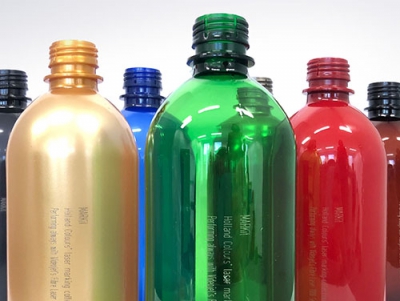How to achieve the optimal laser marking results?
Food brands and PET bottle converters face a dilemma when it comes to preventing counterfeiting and ensuring product safety. Either use inkjet printing to mark bottles with production, use-by and other important information, or engrave this information onto the bottle with a laser.
The possibility of laser marking a plastic product depends upon a lot of variables. A.o. type of laser, type of polymer, application and formulation of the color (choice of pigments).
Most polymers themselves are not laser markable (PVC is an exception). So it is the composition of additives and/or color which is important to create the desired result.

Often it is possible to get a good LM (laser marking) result by changing the pigment formulation. The disadvantage of changing the color formulation is that the desired color cannot always be reached and is often a bit darker or dirtier.
If an exact color is desired, LM additives are often needed. The advantage of LM-additives is that their influence on the color is small. The disadvantage of LM-additives is that they are relatively expensive.
LM is done only on small areas. So when used in bigger products, these additives act like expensive fillers - they are functional where needed but still present where not needed.
So the key to successful color matching and LM is finding an optimum balance between color and cost.
At Holland Colours we used our 40 years of coloring experience to develop colorants based on pigments that naturally react at a certain wavelength of the fiber laser. This know-how resulted in the development of our MarkIt range. HCA is testing with a VJ fiber laser 7310.
Click here to find more information about our MarkIt range. Or contact us. Our specialists are ready to help you find the optimal solution.
.png?width=1200&height=700&name=POSITIVE%20MONDAY%20(1).png)



